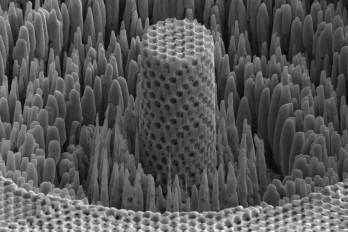Predicting the mechanical properties of metal-organic frameworks using Machine Learning

A new study suggests that machine learning can predict the mechanical properties of metal-organic frameworks, materials that will to be of great importance in the near future.
Metallic-Organic Frameworks or MOFs are complex molecular structures created by the connection of metallic and organic atoms. They have crystalline structure, developing in every direction in space, which is highly porous making them ideal to function as a storage. An impressive fact is that a sugar-cube-sized MOF has a massive surface area about the size of 6 football fields.
MOFs can be utilized for many purposes, including storing toxic gases or extracting the water from the air. "That MOFs are so porous makes them highly adaptable for all kinds of different applications, but at the same time their porous nature makes them highly fragile," Dr. David Fairen-Jimenez from Cambridge's Department of Chemical Engineering and Biotechnology, leader the research and co-author of the study, stated.
They can be customized into numerous combinations and, thus, it's not possible to derive the mechanical properties of each one. However, scientists developed a machine learning algorithm in order to determine the properties of more than 3,000 existing MOFs.
MOFs are produced in powder form. They are unstable materials that may collapse during the manufacturing process due to their porosity. This causes severe financial loss and time waste. Therefore, predicting their mechanical properties ensures that scientists will produce the most durable of them. "We are now able to explain the landscape for all the materials at the same time. This way, we can predict what the best material would be for a given task." Dr. Fairen-Jimenez said.
The team has developed a website where other researchers can evaluate the properties of their MOFs using the produced algorithm. Their aim is to reduce uncertainty in the MOF field. "It allows researchers to access the tools they need in order to work with these materials: it simplifies the questions they need to ask," Dr. David Fairen-Jimenez, added.
Source: Cam.ac.uk
Want to read more like this story?

New lightweight material has the strength of titanium
Feb, 22, 2019 | NewsResearchers have developed a sheet of nickel with nanoscale pores that has the strength of titanium...

Researchers use photos and new AI tool to calculate stress and strain fields of materials
Apr, 28, 2021 | NewsResearchers at Massachusetts Institute of Technology have developed a method to determine stres...
Composite structures
Sep, 07, 2023 | EducationComposite structures refer to constructions that are composed of two or more distinct materials co...

Microspheres can improve concrete's mechanical properties
Oct, 04, 2018 | NewsResearchers have developed micron-sized calcium silicate spheres that could increase concrete's stre...

New method to transform construction waste into useful materials
Dec, 07, 2018 | NewsA group of German researchers has found a way to manipulate construction waste by turning them into...

Sustainable materials can be used in construction to decrease environmental pollution
Apr, 30, 2024 | NewsEfforts to reduce emissions in the building sector typically focus on operational aspects like heat...

EPFL scientists develop hydrogel-based 3D printing that yields metals 20× stronger
Oct, 16, 2025 | NewsResearchers at the École Polytechnique Fédérale de Lausanne(EPFL) have developed an innovative addi...

10 state-of-the-art sustainable materials that will alter construction industry
Jun, 10, 2024 | NewsIn 2024, sustainable materials become state-of-the-art in construction since the construction indus...

Steel or Timber? Carbon footprint of truss structures can be reduced with the aid of new studies
Nov, 29, 2021 | NewsBuildings contribute significantly to global warming, not just in their ongoing operations but in t...
Trending

New Release - STAAD.Pro 2025

Spectacular interchanges around the world

STAAD.Pro 2024 New Release

China: Bridge collapse due to heavy rainfall

STAAD.Pro 2023 - New Bentley Major Release

STAAD.Pro 2025: New Release 25.00.01


